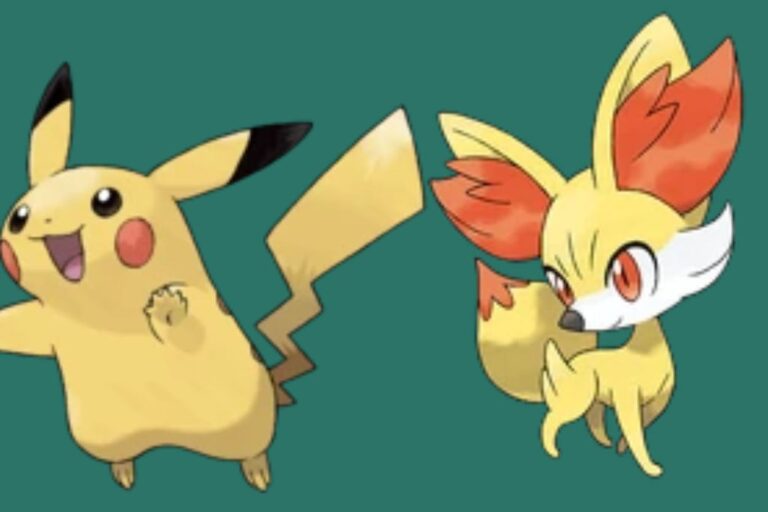Do you carefully choose your starting Pokémon to make sure you have the best beginning for your adventure? If you do, this article is for you! You might remember your favorite starting Pokémon and even discover some new ones from our list of every starter Pokémon organized by generation.
All Starter Pokémon by Generation (Complete List Generation 1-9)
Nintendo has given us many Pokémon games, including both spin-offs and mainline titles spanning from Generation 1 to Generation 9. Players who’ve experienced the main games know how important it is to choose one from the trio of starting Pokémon. Let’s take a quick look at the starter Pokémon from each core Pokémon game throughout history.
Pokémon Gen 1 Starters: Bulbasaur, Charmander, Squirtle, and Pikachu!
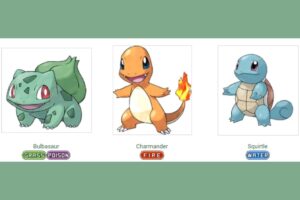
Generation 1 established the classic Grass, Fire, and Water Pokémon trio, a pattern that remains unchanged even after 24 years.
In Pokémon Red, Blue, and Green, players had to choose between Bulbasaur (Grass), Charmander (Fire), and Squirtle (Water). These three Pokémon captured gamers’ hearts at the start of the franchise, making it a tough decision to pick just one as their first partner.
- Bulbasaur -> Ivysaur (level 16) -> Venusaur (level 32)
- Charmander -> Charmeleon (level 16) -> Charizard (level 36)
- Squirtle -> Wartortle (level 16) -> Blastoise (level 36)
These three starters are etched in Pokémon history as some of the most beloved and iconic Pokémon. Many trainers grappled with the choice of which starter to select as they embarked on their maiden journey through the Kanto region. These three stalwarts have since become staples in the franchise and are frequently featured in most Pokémon titles.
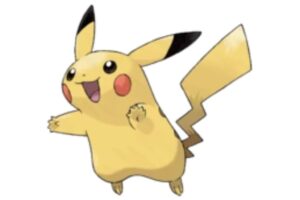
Pikachu, Ash’s trusty companion, stands out as a unique starter Pokémon. Unlike others, Pikachu isn’t chosen from a trio and can’t be confined within a Pokéball. Moreover, players must capture additional Pokémon early in the game to overcome the first gym challenge, as this electric mouse isn’t suitable for the task. Interestingly, players were initially meant to receive an Eevee but instead received a Pikachu.
Pokémon Gen 2 Starters: Chikorita, Cyndaquil, Totodile
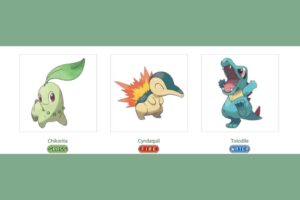
The second generation of Pokémon introduced the Johto region and three new starter Pokémon options. Along with these starters, players had the opportunity to discover and capture 100 new Pokémon, in addition to those from the first generation.
While the second trio of starter Pokémon may not be as universally acclaimed as the first, they boast well-designed characteristics. Many fans found themselves drawn to Totodile or Cyndaquil, primarily due to their formidable final evolutions. Nonetheless, each starter garnered a substantial following within the community.
- Chikorita -> Bayleef (level 16) -> Meganium (level 32)
- Cyndaquil -> Quilava (level 14) -> Typhlosion (level 36)
- Totodile -> Croconaw (level 18) -> Feraligatr (level 30)
Pokémon Gen 3 Starters: Treecko, Torchic, Mudkip
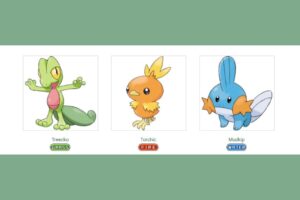
Generation 3 took trainers on an expedition across the Hoenn region, offering a choice between three distinct starter Pokémon. These games introduced not only new Pokémon to capture but also innovative features not seen in previous titles.
Generation 3 marked a turning point for the franchise. Improved graphics and an expanded Pokédex breathed new life into the games. The Hoenn region stood out with its trio of starters: Treecko, Mudkip, and Torchic. All three Pokémon remained viable throughout their evolutions, making them immensely popular among fans. Torchic and Mudkip, in particular, gained favor due to their versatile move sets and final type combinations.
- Treecko -> Grovyle (level 16) -> Sceptile (level 36)
- Torchic -> Combusken (level 16) -> Blaziken (level 36)
- Mudkip -> Marshtomp (level 16) -> Swampert (level 36)
Pokémon Gen 4 Starters: Turtwig, Chimchar, Piplup
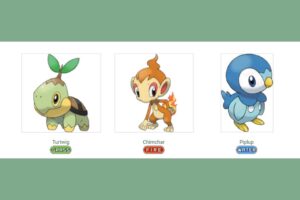
Generation 4 brought a new set of starters along with the Sinnoh region, introducing 107 new Pokémon and a fresh exploration experience. These starters were also the first to be featured in a core Pokémon game for the Nintendo DS.
Sinnoh, the region of Generation 4, remains beloved among long-time Pokémon fans. It offered an enticing array of new Pokémon, an engaging storyline, diverse weather conditions on the map, and a charming trio of starters. Each of the three starters had its own appeal, making the choice a delightful challenge. All three starters exhibited undeniable cuteness, further complicating the decision-making process for trainers.
- Turtwig -> Grotle (level 18) -> Torterra (level 32)
- Chimchar -> Monferno (level 14) -> Infernape (level 36)
- Piplup -> Prinplup (level 16) -> Empoleon (level 36)
Pokémon Gen 5 Starters: Snivy, Tepig, Oshawott
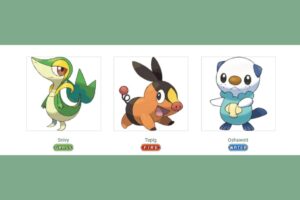
Generation 5 introduced three new starters for the Unova region, along with features such as a new region, changing seasons, and the National Pokédex, accessible after completing the main story.
Generation 5 marked a slight decline in starter Pokémon popularity. Fans had grown weary of the Fire starter, especially since the preceding generations had featured Fire starters with the Fighting type. This led to some reservations regarding Tepig and its eventual evolution into Emboar, a Fire/Fighting type. Moreover, the overall designs of the starters failed to resonate with fans, resulting in Generation 5 having a less memorable trio compared to other generations.
- Snivy -> Servine (level 17) -> Serperior (level 36)
- Tepig -> Pignite (level 17) -> Emboar (level 36)
- Oshawott -> Dewott (level 17) -> Samurott (level 36)
Pokémon Gen 6 Starters: Chespin, Fennekin, Froakie
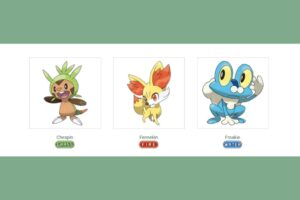
Pokémon X and Y introduced the sixth generation of Pokémon, offering a choice between Chespin, Fennekin, and Froakie as the starter Pokémon. These games are set in the Kalos and Hoenn regions and take place two years after the events of Black and White.
Generation 6 presents a divisive perspective on starter Pokémon. While Froakie stands out as one of the most popular starters ever, Fennekin, particularly its final evolution Delphox, received mixed reviews. Delphox’s bipedal Fire typing didn’t resonate with a majority of players. However, Froakie redeemed the generation with its evolution into Greninja, a top-five starter according to most fans. Chespin, unfortunately, received less attention due to Froakie’s popularity.
- Chespin -> Quilladin (level 16) -> Chesnaught (level 36)
- Fennekin -> Braixen (level 16) -> Delphox (level 36)
- Froakie -> Frogadier (level 16) -> Greninja (level 36)
Pokémon Gen 7 Starters: Rowlet, Litten, Popplio
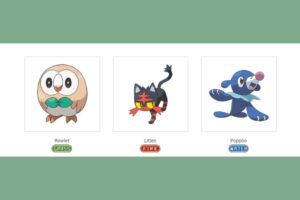
The seventh generation of Pokémon introduced Rowlet, Litten, and Popplio as starter Pokémon. These starters offered a more “ordinary” appearance compared to those in previous generations. Rowlet was the first Flying-type starter, and these games did away with traditional gym leaders.
Generation 7 witnessed the release of Pokémon Let’s Go games before Sword and Shield, inaugurating Generation 8. While not a resounding success with the broader audience, these games introduced a novel gameplay approach. Eevee made its debut as a starter, while Pikachu returned for a second adventure.
- Rowlet -> Dartrix (level 17) -> Decidueye (level 34)
- Litten -> Torracat (level 17) -> Incineroar (level 34)
- Popplio -> Brionne (level 17) -> Primarina (level 34)
Pokémon Gen 8 Starters: Grookey, Scorbunny, and Sobble
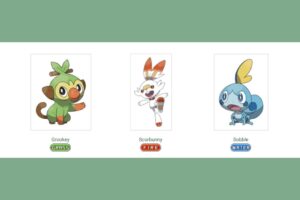
Generation 8 unfolds in the Galar region, where trainers select their starter Pokémon from Grookey, Scorbunny, and Sobble. These games introduced Gigantamax forms in battles, with Gigantamax Pokémon displaying tremendous size and unique appearances.
Generation 8 brought us the most recent starters in main series Pokémon games: Grookey, Sobble, and Scorbunny. These starters were generally well-received, featuring creative designs. However, their final evolutions opted for single typings, a decision that drew mixed opinions among players. Nevertheless, Generation 8’s starters marked a positive step forward for the franchise.
- Grookey -> Thwackey (level 16) -> Rillaboom (level 35)
- Scorbunny -> Raboot (level 16) -> Cinderace (level 35)
- Sobble -> Drizzile (level 16) -> Inteleon (level 35)
Pokémon Gen 9 Starters: Rowlet, Cyndaquil, and Oshawott
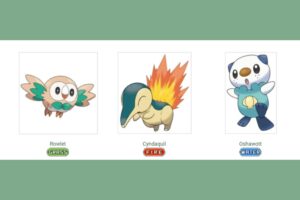
The events in Pokémon Legends: Arceus unfold in Hisui, formerly known as Sinnoh. As a result, players encounter returning Pokémon as starter options. These starters’ final evolutions are regional variants, offering distinct appearances compared to their previous forms.
Pokémon Legends: Arceus marked a significant departure from the classic Pokémon gameplay loop. This open-world game introduced new mechanics for catching and battling Pokémon, with players taking on missions themselves. The starters for this game comprise a mix of different generations, including Cyndaquil, Oshawott, and Rowlet.
- Quaxly => Quazwell – lvl 16 => Quaquaval – lvl 36
- Sprigatitio => Floragato – lvl 16 => Meowscarada – lvl 36
- Fueococo => Crocalor – lvl 16 => Skeledirge – lvl 36
All Starters in Pokémon Scarlet & Violet
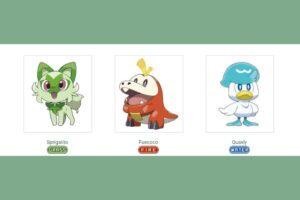
Pokémon Scarlet and Violet are the latest core titles, introducing Generation 9 Pokémon, including the three starters: Sprigatito, Fueococo, and Quaxly. Players select one of these starters at the outset of their journey in the Paldea region.
Generation 9 marks the final chapter of Pokémon and its starters. The reveal of the starters in Scarlet and Violet generated immediate excitement among fans, especially for Sprigatito, the Grass-type cat Pokémon. Nevertheless, the Fire-type dinosaur and the Water-type duck with a hat have their own share of fans. It remains uncertain how these starters will be perceived once Scarlet and Violet launch in November.
Conclusion:
Throughout the Pokémon universe, we’ve been introduced to a diverse array of starting Pokémon. Each starter brings its unique set of skills and characteristics to the table, from the classic trio of Bulbasaur, Charmander, and Squirtle to the more recent additions of Grookey, Scorbunny, and Sobble.
There’s a starter Pokémon for every preference, whether you favor Grass, Fire, or Water types. As indispensable members of a trainer’s team, each starter possesses its own strengths and weaknesses, contributing to the rich tapestry of the Pokémon world.

A computer engineer by day, gamer by night. He grew up playing Mario and contra, and just like every other 90s kid, he got passionate about mobile gaming. He had done bachelors in computer science and played fps and MOBA games for years.
